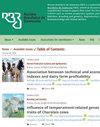品种和杂种优势对吉兰多奶牛繁殖和生产性状的影响
IF 1.2
4区 农林科学
Q3 Agricultural and Biological Sciences
Revista Brasileira De Zootecnia-Brazilian Journal of Animal Science
Pub Date : 2022-01-01
DOI:10.37496/rbz5120200266
引用次数: 1
摘要
本研究旨在评价杂交吉兰多奶牛生殖性状、试验日产奶量和不同泌乳期305日产奶量对品种和杂种优势的影响。数据包括1998年至2014年收集的35582头巴西吉兰多奶牛的第一次泌乳(118831次)、第二次泌乳(63227次)和第三次泌乳(44512次)试验日产奶量记录,以及它们的相对产奶量(试验日产奶量、305天产奶量和泌乳时长)和繁殖量(初产龄、产犊间隔、开乳天数和干乳期)记录。采用SAS的MIXED方法对评价性状在吉兰多牛中的杂种优势效应进行了评价。吉兰多奶牛在生殖性状上表现出负(有利)和显著的杂种优势效应。第一次和第二次产犊之间和第二次和第三次产犊之间的干旱期杂种优势增益最大(分别为21.93%和10.41%)。所有评价的生产性状在三个哺乳期之间均表现出显著且相似的杂种优势效应。在荷斯坦和吉尔品种之间使用杂交策略,而不是使用纯品种,确实是一个很好的选择,以提高在热带环境中不同生产系统中乳制品活动的经济效率。本文章由计算机程序翻译,如有差异,请以英文原文为准。
Breed and heterosis effects on reproduction and production traits of Girolando cows
The objective of this study was to evaluate the breed and heterosis effects on reproductive traits, test-day milk yield, and 305-day milk yield in different lactations of crossbred Girolando cows. Data consisted of test-day milk yield records of first (118,831 records), second (63,227), and third lactation (44,512) and their relative productive (test-day milk yield, 305-day milk yield, and lactation length) and reproductive (age at first calving, calving interval, days open, and dry period) records of 35,582 Girolando cows from Brazil, collected from 1998 to 2014. The heterosis effect of the evaluated traits in Girolando cattle was estimated by MIXED procedure in SAS. Girolando cows showed a negative (favorable) and significant heterosis effect for reproductive traits. The dry periods between the first and second calving and between the second and third calving showed the greatest gains in heterosis (21.93 and 10.41%, respectively). All the evaluated productive traits showed a significant and similar heterosis effect between the three lactations. The use of crossbreeding strategies between the Holstein and Gyr breeds, instead of using the pure breed, is indeed a good alternative to increase the economic efficiency of the dairy activity in the different production systems in tropical environments.
求助全文
通过发布文献求助,成功后即可免费获取论文全文。
去求助
来源期刊
CiteScore
1.90
自引率
0.00%
发文量
25
审稿时长
8 weeks
期刊介绍:
The Revista Brasileira de Zootecnia (RBZ; Brazilian Journal of Animal Science) encompasses all fields of Animal Science Research. The RBZ publishes original scientific articles in the areas of Aquaculture, Biometeorology and Animal Welfare, Forage Crops and Grasslands, Animal and Forage Plants Breeding and Genetics, Animal Reproduction, Ruminant and Non-Ruminant Nutrition, and Animal Production Systems and Agribusiness.

 求助内容:
求助内容: 应助结果提醒方式:
应助结果提醒方式:


